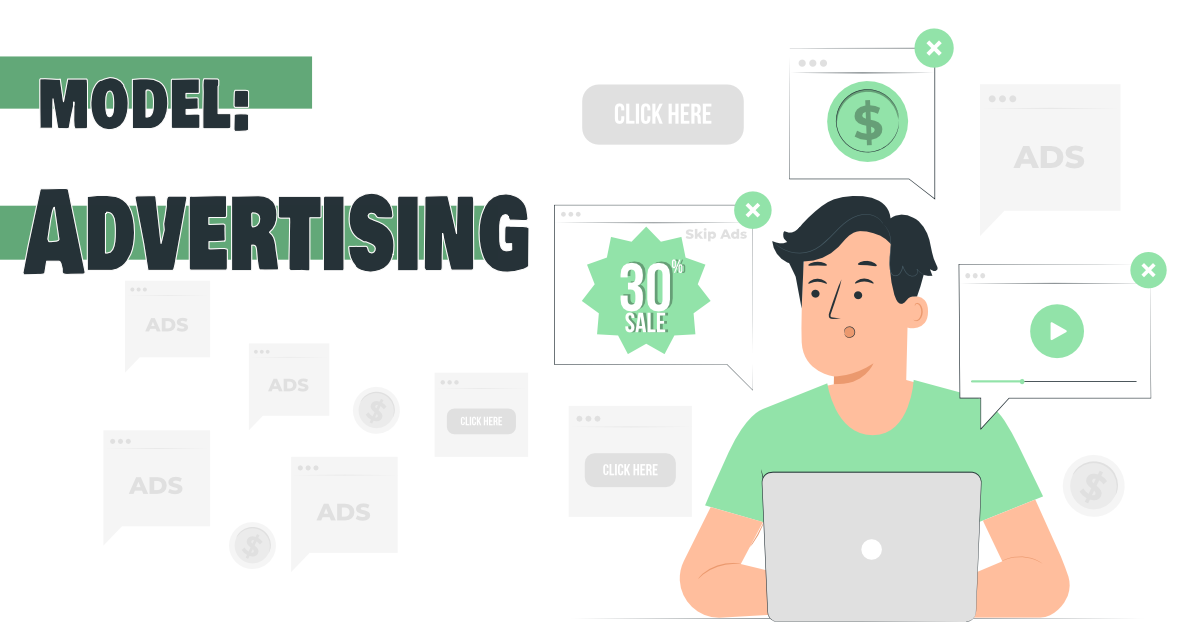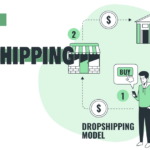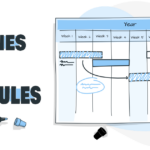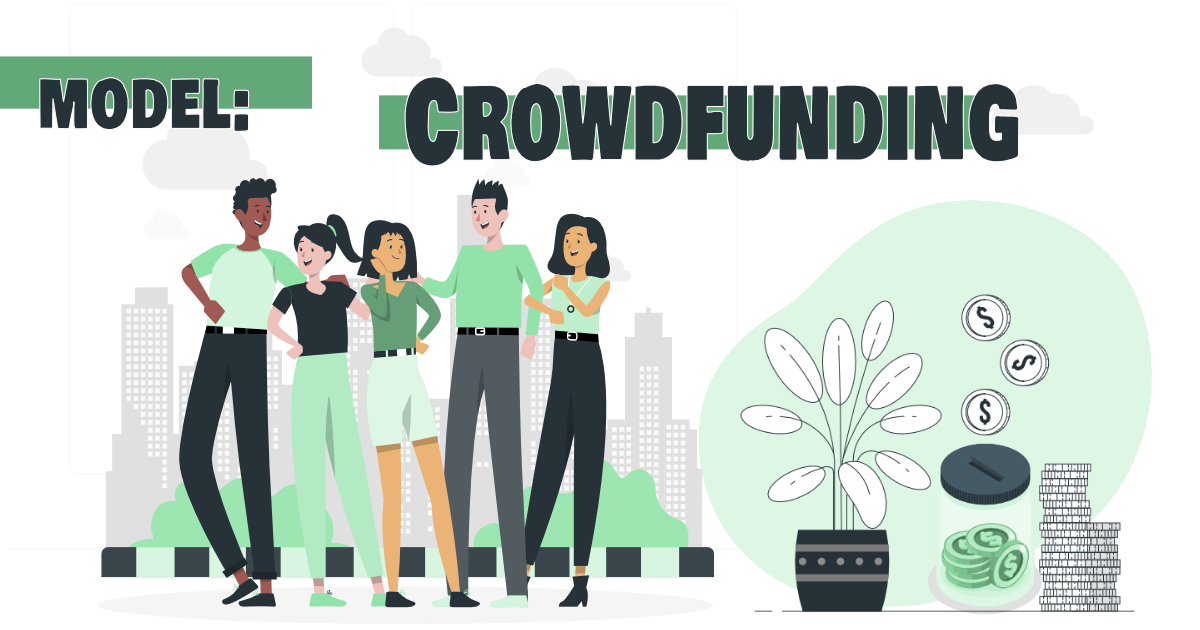The advertising-based model is a business model where a company generates revenue through advertising rather than through the sale of products or services. This model is prevalent in many industries, including media, tech, and software, and has become a popular way for businesses to monetize their products and services. In this model, a company allows advertisers to place their advertisements on its website, application, or platform in exchange for a fee. The company benefits from increased exposure and brand recognition while the advertiser reaches a wider audience. This model is often used in conjunction with other business models to provide additional sources of revenue.
Overview of advertising-based model
The advertising-based model is a business model that is gaining popularity among e-commerce entrepreneurs. In this model, the business generates revenue by selling advertising space on their platform. This can take the form of sponsored product listings, display ads, or other forms of advertisements. The key advantage of this model is that it provides a steady stream of revenue without having to hold any inventory or manage any shipping or delivery processes.
The process of operating an advertising-based model e-commerce business typically involves the following steps:
- Building a platform: The first step is to build a platform that is attractive and engaging to potential advertisers. This can include a website, a mobile app, or other forms of digital media.
- Attracting visitors: Once the platform is built, the next step is to attract visitors. This can be done through various means such as SEO, social media marketing, influencer marketing, or paid advertising.
- Building relationships with advertisers: Once you have a steady stream of visitors, the next step is to build relationships with advertisers. This can involve reaching out to potential advertisers and offering them a variety of advertising options on your platform.
- Selling advertising space: Once you have built relationships with advertisers, the next step is to sell advertising space. This can involve setting up an online marketplace where advertisers can browse and purchase available advertising space, or it can involve negotiating deals directly with advertisers.
- Managing advertising campaigns: Once the advertising space has been sold, the next step is to manage the advertising campaigns. This involves ensuring that the advertisements are displayed correctly, tracking the performance of the campaigns, and making any necessary adjustments to improve results.
- Optimizing for revenue: The final step is to continually optimize your advertising-based model for maximum revenue. This can involve conducting regular performance analysis, experimenting with different ad formats and targeting methods, and adjusting your pricing structure as needed.
Best Practices
- Offering a variety of advertising options: To maximize revenue, it is important to offer a variety of advertising options, such as sponsored product listings, display ads, and other forms of advertisements.
- Providing high-quality customer service: Providing high-quality customer service is critical for building strong relationships with advertisers and ensuring their satisfaction with your platform.
- Optimizing for mobile: With the growing popularity of mobile devices, it is important to optimize your platform for mobile users to ensure that your advertisements are seen by as many people as possible.
- Continuously experimenting: Continuously experimenting with different ad formats, targeting methods, and pricing structures is crucial for finding the optimal solution for your business.
In conclusion, the advertising-based model is a promising business model for e-commerce entrepreneurs looking to generate revenue without the hassle of managing inventory and shipping. By building a platform, attracting visitors, building relationships with advertisers, selling advertising space, and continually optimizing for maximum revenue, businesses can maximize the potential of this model.
Types of products and services offered
In an advertising-based business model, the products and services offered can vary greatly depending on the company’s focus and target audience. However, there are several common types of products and services that are often offered within this model.
- Display advertising: This involves the use of visual ads, such as banner ads or video ads, to promote products or services. These types of ads are often placed on websites, social media platforms, or other digital media channels where potential customers are likely to see them.
- Affiliate marketing: In this model, businesses partner with affiliates who promote their products or services in exchange for a commission on any resulting sales. This type of advertising is often used by e-commerce companies or digital marketers.
- Sponsored content: This involves creating content that is sponsored by a brand, with the aim of promoting its products or services. This type of advertising can take the form of blog posts, videos, or other types of content that are created specifically to promote a brand.
- Influencer marketing: This involves partnering with individuals who have a large following on social media platforms, and using their reach to promote products or services. Brands often pay influencers to share posts about their products or to create content that promotes the brand.
- Native advertising: This is a type of advertising that is designed to blend in with the content that it appears alongside. Native ads often take the form of sponsored articles or sponsored social media posts, and are designed to look like regular content rather than traditional ads.
When deciding which types of products or services to offer within an advertising-based business model, it is important to consider the target audience, the goals of the business, and the available resources. A company may choose to offer a combination of these types of advertising, or may focus on just one or two types that are most relevant to their target audience and business goals.
Best Practices
- Conducting market research to understand the target audience,
- Offering a range of products and services that meet the needs of that audience, and
- Creating high-quality, engaging content that will effectively promote the brand.
In conclusion, the types of products and services offered within an advertising-based model can vary greatly, but often include display advertising, affiliate marketing, sponsored content, influencer marketing, and native advertising. To succeed in this model, it is important to understand the target audience, offer products and services that meet their needs, and create high-quality content that effectively promotes the brand.
Customer demographics
In the advertising-based model, it is crucial to understand the customer demographics to effectively target and reach the right audience. Customer demographics refer to the characteristics of a specific group of consumers, such as age, gender, income, education, and location. Understanding the customer demographics helps businesses tailor their products and services, marketing strategies, and advertising efforts to better align with the needs and preferences of their target audience.
The process of identifying customer demographics typically involves the following steps:
- Data Collection: Collect data on your customers, including their age, gender, income, education, and location, through surveys, online analytics, and customer feedback.
- Segmentation: Divide the customer data into different segments based on the demographic information. For example, you can segment customers based on their age, income, or location.
- Analysis: Analyze the data to understand the demographics of your target audience. Identify patterns and trends in the data to better understand their needs and preferences.
- Strategy Development: Based on the analysis, develop a targeted marketing and advertising strategy that appeals to the specific demographics of your customers.
Examples of using customer demographics in advertising-based models include targeting specific age groups with particular products, targeting high-income individuals with premium products, and targeting urban dwellers with specific services.
Best Practices
- Regularly updating customer data: Regularly collect and analyze customer data to ensure that your understanding of their demographics stays up-to-date.
- Segmenting the audience: Segment your target audience into specific demographics to better tailor your marketing and advertising efforts.
- Keeping the target audience in mind: Always keep the target audience in mind when creating advertising and marketing campaigns.
Actionable Tips
- Conduct market research to understand the needs and preferences of your target audience.
- Use customer data to create targeted marketing and advertising campaigns.
- Test different advertising and marketing strategies to see what resonates with your target audience.
In conclusion, understanding customer demographics is critical in the advertising-based model as it helps businesses effectively target and reach the right audience. Regular data collection, segmentation, analysis, and strategy development are key steps in utilizing customer demographics in advertising-based models.
Revenue generation through advertising
Revenue generation through advertising is an integral part of the advertising-based business model. This model relies on generating revenue from advertising by offering products and services to customers for free or at a reduced cost. In order to generate revenue, businesses in this model must attract a large number of customers and provide a platform that is attractive to advertisers.
There are several steps involved in generating revenue through advertising:
- Understanding target demographics: Businesses must first understand their target customers, including their age, gender, location, interests, and purchasing behaviors. This information can be gathered through customer surveys, market research, and analysis of data from customer transactions.
- Developing an attractive platform: Businesses must develop a platform that is appealing to both customers and advertisers. This can include offering a range of products and services that are relevant to their target demographic, as well as providing engaging content and a user-friendly interface.
- Building a strong advertising network: Businesses must build a network of advertisers who are willing to pay for advertising space on their platform. This network can be built through outreach to potential advertisers, attending industry events, and leveraging existing relationships.
- Maximizing advertising revenue: To maximize advertising revenue, businesses must ensure that their platform is seen by as many customers as possible. This can be achieved through search engine optimization (SEO), pay-per-click advertising, and social media marketing.
- Monitoring performance: Regularly monitoring advertising performance is important in order to identify areas for improvement and optimize revenue generation. This can include tracking metrics such as click-through rates, conversion rates, and customer engagement.
Best Practices
- Offering relevant and valuable products and services to customers
- Building a strong and attractive platform
- Establishing a network of high-quality advertisers
- Regularly monitoring and optimizing advertising performance
- Continuously gathering and analyzing data on customer demographics and behavior.
In conclusion, revenue generation through advertising is an important aspect of the advertising-based business model. Businesses in this model must understand their target demographic, provide a platform that is attractive to both customers and advertisers, and build a strong advertising network in order to maximize advertising revenue. By following best practices and continuously monitoring and optimizing performance, businesses can effectively generate revenue through advertising and succeed in this business model.
Advertiser management and targeting
Advertiser management and targeting are critical components of an advertising-based business model. Advertisers are the companies or individuals that purchase ad space on your platform and use it to reach potential customers. Effective management of these advertisers is key to the success of your business.
Steps in Advertiser Management:
- Identifying potential advertisers: Research potential advertisers in your niche or industry that might be interested in advertising on your platform. You can use online tools and databases to research companies, their target audiences, and their advertising budgets.
- Approaching advertisers: Reach out to potential advertisers through email, phone, or in-person meetings to introduce your platform and explain why it would be a good fit for their advertising needs.
- Negotiating and closing deals: Work with advertisers to agree on the terms of their ad campaigns, including the size and placement of the ads, the duration of the campaigns, and the cost.
- Managing campaigns: Once advertisers are on board, monitor their campaigns to ensure they are running smoothly and delivering the desired results.
Targeting
Advertisers want to reach their target audience, and you need to help them do this by providing effective targeting options. You can target by demographic, location, interests, behavior, or a combination of these factors. The more accurate and specific your targeting options are, the more valuable your platform will be to advertisers.
Relevant Examples
- Google AdSense: This is a popular advertising platform that allows website owners to display ads on their sites and earn money when users click on them. AdSense uses a range of targeting options, including demographic, location, interests, and behavior, to help advertisers reach their target audience.
- Facebook Ads: This platform provides a range of targeting options, including demographic, location, interests, and behaviors. It also allows advertisers to target users based on their interactions with their Facebook pages, such as liking a page or commenting on a post.
Real–Life Examples
- A fashion retailer wants to advertise its latest collection to women aged 18-35 who live in the United States and are interested in fashion and beauty. The advertiser could use Facebook Ads to target this audience by specifying these demographics and interests.
- A car dealership wants to advertise its latest models to men aged 25-55 who live in a specific city and are interested in cars. The advertiser could use Google AdSense to target this audience by specifying these demographics and interests.
Best Practices
- Offer a range of targeting options to give advertisers the ability to reach their desired audience.
- Continuously update and refine your targeting options to improve their accuracy and effectiveness.
- Monitor and optimize ad campaigns to ensure they are delivering the desired results for advertisers.
- Provide transparent and detailed reporting to advertisers to show the performance of their campaigns.
Actionable Tips
- Identify the target audience of your platform and use this information to inform your targeting options.
- Offer a range of targeting options, including demographic, location, interests, and behaviors, to give advertisers the ability to reach their desired audience.
- Continuously test and refine your targeting options to improve their accuracy and effectiveness.
- Monitor and optimize ad campaigns to ensure they are delivering the desired results for advertisers.
In conclusion, advertiser management and targeting are critical components of an advertising-based business model. By offering a range of targeting options and continuously refining them, you can help advertisers reach their target audience and generate revenue for your platform.
Marketing and advertising strategies
Marketing and advertising strategies are crucial for the success of an advertising-based model. These strategies are used to attract and retain customers, increase brand awareness, and ultimately generate more revenue. The following are the key steps involved in developing a marketing and advertising strategy:
- Define your target audience: Understanding who your target audience is, their interests, and behavioris crucial to developing effective marketing and advertising strategies. This information can be obtained through market research, surveys, and data analysis.
- Identify your unique value proposition: Determine what makes your advertising platform unique and how you can differentiate yourself from your competitors. This could be in the form of a specific target audience, a range of targeting options, or innovative advertising formats.
- Develop your marketing mix: The marketing mix consists of the 4 Ps – product, price, promotion, and place. Determine the best ways to position your advertising platform in the market and what strategies to use to promote it.
- Choose your advertising channels: Decide which channels you will use to reach your target audience. This could include online advertising, social media, email marketing, or traditional media such as TV and print.
- Implement and monitor: Once you have developed your marketing and advertising strategies, it’s time to implement them and monitor their performance. Regularly track your key metrics, such as website traffic, conversion rates, and ad click-through rates, to assess the effectiveness of your strategies and make any necessary changes.
Relevant Examples
- Google AdWords: This is a pay-per-click advertising platform that allows businesses to place ads on Google’s search results pages and display network. AdWords uses a combination of keywords and targeting options to reach a specific audience and drive traffic to a website.
- Influencer Marketing: This is a strategy where a brand partners with an influencer, who has a large following on social media, to promote its products or services. The influencer may receive compensation in the form of money, products, or services in exchange for promoting the brand to their followers.
Real–Life Examples
- A clothing company partners with a popular fashion influencer on Instagram to promote its latest collection. The influencer posts pictures of themselves wearing the clothes, tagging the company and using specific hashtags, to reach their large following and drive sales.
- A small business runs a Google AdWords campaign targeting local users who search for keywords related to their product or service. The ads appear at the top of Google’s search results pages and drive traffic to the business’s website.
Best Practices
- Regularly review and update your marketing and advertising strategies to ensure they remain relevant and effective.
- Use data and analytics to inform your strategies and measure their effectiveness.
- Test different strategies and channels to determine which ones are the most effective.
- Be creative and innovative in your marketing and advertising efforts to stand out from your competitors.
Actionable Tips
- Define your target audience and understand their needs and behavior.
- Identify your unique value proposition and use it to differentiate yourself from your competitors.
- Choose your advertising channels based on your target audience and budget.
- Regularly monitor and adjust your marketing and advertising strategies to ensure their effectiveness.
In conclusion, an effective marketing and advertising strategy is essential for the success of an advertising-based business model. By defining your target audience, identifying your unique value proposition, and using data and analytics to inform your strategies, you can increase brand awareness and generate more revenue.
Data analysis and optimization
The advertising-based model relies heavily on data and analysis to be successful. The collected data allows businesses to optimize their advertising strategies and increase their revenue. In this article, we will cover the steps involved in the data analysis and optimization process for an advertising-based model.
Step 1: Collecting Data
The first step in data analysis and optimization is to collect data. This data can be obtained from various sources, including website analytics, customer feedback, and advertising metrics. The data collected should include information on customer demographics, behavior patterns, and the performance of the advertising campaigns.
Step 2: Cleaning and Organizing Data
Once the data is collected, it needs to be cleaned and organized. This involves removing any irrelevant or duplicate data, and organizing it into a format that is easy to analyze. The data can be organized into spreadsheets, databases, or other tools that are specifically designed for data analysis.
Step 3: Analyzing Data
The next step is to analyze the data. This involves using tools and techniques to identify trends, patterns, and insights. For example, businesses can use regression analysis to identify the factors that are most influential in driving customer behavior. They can also use data visualization tools to create charts, graphs, and other visual representations of the data.
Step 4: Optimizing Advertising Strategies
Once the data is analyzed, businesses can use the insights they have gained to optimize their advertising strategies. This may involve adjusting their target audience, changing the messaging of their advertisements, or adjusting the placement of their advertisements. The goal of this step is to make sure that the advertising campaigns are as effective as possible in generating revenue.
Best Practices and Actionable Tips
- Make sure to regularly collect and analyze data, as this is the key to success in an advertising-based model.
- Use tools that are specifically designed for data analysis, such as spreadsheets, databases, and data visualization tools.
- Regularly evaluate and adjust your advertising strategies to make sure that they are as effective as possible.
- Focus on understanding your target audience, as this will help you to create advertisements that are more relevant and appealing to them.
In conclusion, data analysis and optimization is a critical component of success for an advertising-based model. By regularly collecting, cleaning, and analyzing data, businesses can make informed decisions that will help them increase their revenue. With the right tools and techniques, businesses can gain valuable insights into their target audience and create advertising campaigns that are more effective in generating revenue.
Competitor analysis
Competitor analysis is a critical aspect of any advertising-based business model, as it helps businesses to understand the market landscape and position themselves accordingly. By identifying and analyzing the strengths, weaknesses, and strategies of competitors, businesses can gain a competitive advantage and make informed decisions about their advertising and marketing strategies.
The process of competitor analysis typically involves the following steps:
- Identifying key competitors: This step involves identifying the main players in the market and understanding their market position. This can be done by researching their product offerings, marketing strategies, target demographics, and overall brand presence.
- Gathering data: Next, businesses need to gather data about their competitors, including financial information, marketing campaigns, and customer feedback. This information can be obtained through a variety of sources, such as websites, press releases, customer reviews, and industry reports.
- Analyzing competitor strategies: Once data has been gathered, it is time to analyze competitor strategies and identify their strengths and weaknesses. This can include evaluating the success of their advertising campaigns, analyzing customer feedback, and determining the effectiveness of their marketing strategies.
- Evaluating market share: To determine the size and position of a competitor in the market, it is important to evaluate their market share. This can be done by analyzing market data and trends, as well as by tracking their growth and success over time.
- Creating a SWOT analysis: A SWOT analysis (Strengths, Weaknesses, Opportunities, and Threats) is a useful tool for evaluating competitor strategies and determining areas for improvement.
- Developing a competitive advantage: Based on the insights gained from the competitor analysis, businesses can develop a competitive advantage by leveraging their strengths and exploiting their competitor’s weaknesses.
When conducting a competitor analysis, it is important to keep in mind that the advertising and marketing landscape is constantly changing, so businesses should regularly re-evaluate their competitors and adjust their strategies accordingly.
Relevant examples of competitor analysis in the advertising industry include social media companies analyzing the strategies of each other to improve their own advertising offerings, and companies in the e-commerce space analyzing the marketing strategies of Amazon to determine how to better target their customers.
Best practices for competitor analysis include staying up-to-date with industry trends and regularly monitoring competitors, using data-driven insights to inform decisions, and constantly evaluating and adjusting strategies as needed.
In conclusion, competitor analysis is an essential aspect of any advertising-based business model, as it allows businesses to understand the market landscape and position themselves accordingly. By identifying and analyzing competitor strategies, businesses can gain a competitive advantage and make informed decisions about their advertising and marketing strategies.
Monetization strategies
In an advertising-based model, monetization is the process of generating revenue from advertisements. Two of the most common monetization strategies used in this model are cost per click (CPC) and cost per impression (CPI).
Cost per click (CPC) refers to the amount advertisers pay for each click on their ads. In this model, the advertiser sets a budget for their advertising campaign and pays each time a user clicks on their ad. For example, a company may set a budget of $1000 for a CPC campaign and pay $0.10 each time a user clicks on their ad.
Cost per impression (CPI) refers to the amount advertisers pay for each impression or view of their ad. In this model, the advertiser pays a set amount each time their ad is displayed to a user, regardless of whether the user clicks on the ad or not. For example, a company may pay $0.05 each time their ad is displayed to a user 1000 times.
To determine the right monetization strategy, it’s important to consider your target audience and the goals of your advertising campaign. If your goal is to generate high amounts of traffic to your website, then CPC may be a better option. However, if your goal is to raise brand awareness, then CPI may be more appropriate.
In terms of best practices, it’s important to regularly analyze and optimize your advertising campaigns. This can involve adjusting your target audience, adjusting your bids, and testing different ad formats. It’s also important to track your advertising campaign’s performance to see which strategies are working and which ones need improvement.
There are several other monetization strategies that can be used in an advertising-based model. Some of these include:
- Cost per action (CPA): This strategy charges the advertiser when a specific action is taken by the user, such as filling out a form or making a purchase.
- Affiliate marketing: In this strategy, an advertiser pays a commission to an affiliate marketer for each sale or lead generated from the advertiser’s advertisements.
- Sponsored content: This strategy involves creating sponsored content that is relevant to the target audience and provides value, with the purpose of promoting the advertiser’s brand.
- Display advertising: This strategy involves placing advertisements on websites and other digital platforms to reach a target audience.
- Influencer marketing: This strategy involves partnering with social media influencers to promote products and services to their followers.
To conclude, there are several monetization strategies available in an advertising-based model, including CPC and CPI. The right strategy depends on your target audience and advertising goals. Regular analysis and optimization is key to success in this model.
User experience and engagement
User experience (UX) and engagement are critical components of any advertising-based model. They play a significant role in determining the success of your advertising efforts and revenue generation. In this article, we will cover the following aspects of UX and engagement in advertising-based models:
What is user experience and engagement in advertising-based models?
User experience refers to the overall satisfaction and perception of a user when interacting with a product or service. In the context of advertising-based models, UX refers to the experience a user has when interacting with advertising content. Engagement, on the other hand, refers to the level of interaction and participation a user has with the advertising content. It could range from simply viewing the ad to taking a desired action such as clicking on the ad or making a purchase.
Why is UX and engagement important for advertising-based models?
UX and engagement are critical factors that influence the success of advertising-based models. A positive UX increases the likelihood of users engaging with advertising content, which leads to higher revenue generation. A user-friendly and engaging advertising experience can also lead to increased brand loyalty and user retention. On the other hand, a negative UX and low engagement can result in users ignoring or avoiding advertising content, leading to lower revenue generation and decreased brand loyalty.
How to optimize UX and engagement in advertising-based models?
There are several steps you can take to optimize UX and engagement in advertising-based models. These include:
- Understanding your target audience: This involves conducting research to understand the preferences, behaviors, and motivations of your target audience. This information can be used to tailor advertising content that appeals to your target audience and enhances their experience.
- Creating relevant and high-quality advertising content: The advertising content should be relevant to the target audience, informative, and visually appealing. High-quality advertising content increases the chances of user engagement and increases the overall UX.
- Using data-driven approaches: Data analysis can help you understand which advertising strategies and tactics are working best. This information can be used to optimize your advertising efforts and improve UX and engagement.
- Testing and refining your advertising strategies: Regular testing and refinement of your advertising strategies can help you identify areas for improvement and optimize your advertising efforts.
Relevant Examples and Real-Life Scenarios
A great example of a company that has optimized UX and engagement in its advertising-based model is Google. The company uses data-driven approaches and user testing to continually improve its advertising experience. This has resulted in a highly-engaging and user-friendly advertising experience, leading to increased revenue generation and brand loyalty.
Best Practices and Actionable Tips
- Understand your target audience and tailor your advertising content accordingly
- Create high-quality and relevant advertising content
- Use data-driven approaches to understand and optimize your advertising efforts
- Regularly test and refine your advertising strategies
In conclusion, UX and engagement are critical components of any advertising-based model. A positive UX and high engagement lead to increased revenue generation, brand loyalty, and user retention. By understanding your target audience, creating high-quality and relevant advertising content, and using data-driven approaches, you can optimize UX and engagement in your advertising-based model.
Ad standards and regulations
Ad standards and regulations are an important aspect of advertising-based models as it ensures that the advertisements being displayed to the users are in compliance with the rules and regulations set forth by the governing bodies.
Why ad standards and regulations are important
- Protect consumers from false or misleading advertisements
- Maintains the integrity of the advertising industry
- Prevents exploitation and discrimination
- Promotes ethical behavior in advertising practices
How to comply with ad standards and regulations
- Know the regulations: It is important to have a clear understanding of the rules and regulations set by the governing bodies such as Federal Trade Commission (FTC) in the US and the Advertising Standards Authority (ASA) in the UK.
- Review advertisements: Before displaying an advertisement, it is important to review the content and ensure that it complies with the ad standards and regulations.
- Monitor the advertisements: Continuous monitoring of the advertisements to ensure they remain in compliance with the rules and regulations.
- Keep records: It is important to keep records of the advertisements displayed, the review process and any necessary changes made to comply with the ad standards and regulations.
Relevant Examples
- Misleading advertisements about weight loss products that promise quick results without proper diet and exercise can be considered a violation of ad standards and regulations.
- Advertisements that use discriminatory language or images can also be considered a violation of ad standards and regulations.
Best Practices
- Be truthful in advertising claims and avoid making false or misleading statements
- Use language and images that are not discriminatory or offensive
- Be transparent about the nature of the product or service being advertised
- Disclose any material information that may affect a consumer’s decision to purchase a product or service.
Actionable Tips
- Regularly review the advertisements to ensure they remain in compliance with the ad standards and regulations
- Invest in a software that can automatically flag any violations of ad standards and regulations
- Have a designated team or person responsible for reviewing and monitoring advertisements
In conclusion, complying with ad standards and regulations is crucial for maintaining the integrity of the advertising industry and protecting consumers from false or misleading advertisements. By following the steps outlined above and implementing best practices, advertisers can ensure their advertisements are in compliance with the rules and regulations set forth by governing bodies.
Resources and References
- “Mastering the Art of Selling Advertising Space” by Al Lautenslager
- “Start Your Own E-Commerce Business” by Entrepreneur Press
- “The Ultimate Guide to Dropshipping” by Anton Kraly
- “Influence: The Psychology of Persuasion” by Robert Cialdini
- “Contagious: How to Build Word of Mouth in the Digital Age” by Jonah Berger
- “Marketing Management” by Philip Kotler and Kevin Lane Keller
- “Marketing Metrics: The Definitive Guide to Measuring Marketing Performance” by Paul W. Farris, Neil T. Bendle, Phillip E. Pfeifer, and David J. Reibstein
- “Advertising Management” by Rajendra Nargundkar
- “Contagious: How to Build Word of Mouth in the Digital Age” by Jonah Berger
- “Made to Stick: Why Some Ideas Survive and Others Die” by Chip Heath and Dan Heath
- “The Art of Digital Marketing: The Definitive Guide to Creating Strategic” by Ian Dodson
- “The Lean Startup: How Today’s Entrepreneurs Use Continuous Innovation to Create Radically Successful Businesses” by Eric Ries
- “Data Analytics Made Accessible” by Anil Maheshwari
- “Advertising Analytics 2.0: The Guide to Paid Search and Social Media Optimization” by David Rodnitzky
- “Data-Driven: Creating a Data Culture” by Hilary Mason and DJ Patil
- “Competitive Intelligence: How to Gather, Analyze, and Use Information to Move Your Business to the Top” by Larry Kahaner
- “Competitive Intelligence: A Framework for Web-based Analysis and Decision Making” by John J. Sviokla and Andrew R. McHugh
- “The Art of SEO: Mastering Search Engine Optimization” by Eric Enge
- “Pay Per Click Search Engine Marketing: An Hour a Day” by ppc expert Brad Geddes
- “Duct Tape Marketing: The World’s Most Practical Small Business Marketing Guide” by John Jantsch
- “Advertising and Promotion: An Integrated Marketing Communications Perspective” by George E. Belch and Michael A. Belch
- “Don’t Make Me Think: A Common Sense Approach to Web Usability” by Steve Krug
- “Advertising Law: A Guide to Marketing and Promotional Law” by John J. Kircher
- “Advertising and Promotion: An Integrated Marketing Communications Perspective” by George E. Belch and Michael A. Belch
- “The Advertiser’s Handbook for Effective Radio Advertising” by Mark D. Langsam













